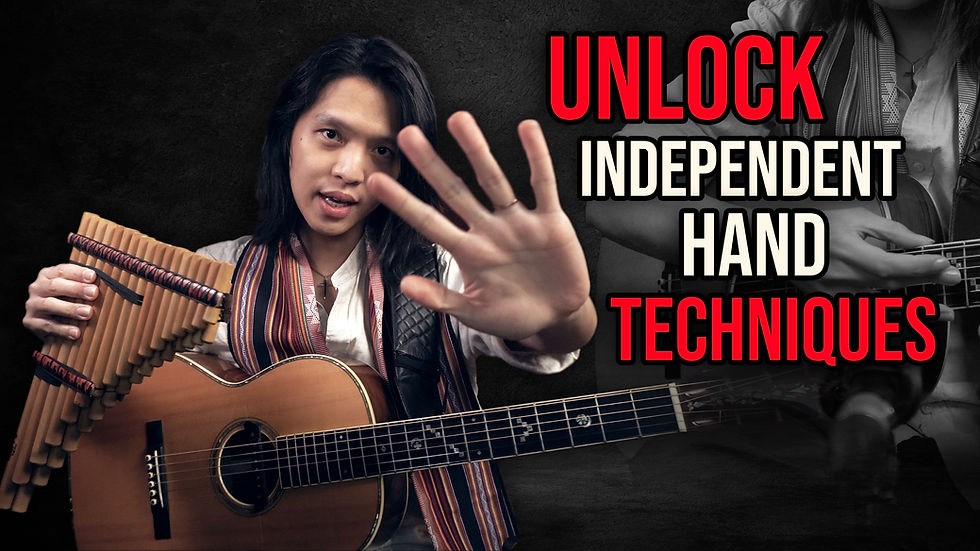Learn to Play Percussion on Guitar ALL BY YOURSELF!
- Neil Chan

- Nov 26, 2021
- 3 min read
Introduction
You can learn to play percussion on guitar, and you can learn it ALL BY YOURSELF! Yes I mean without a teacher, spending zero dollars. This increasingly popular style of guitar playing, whether you call it percussive fingerstyle guitar, modern fingerstyle, guitar drumming, or whatever it is, can be broken down into a few simple concepts that can guide you in discovering your own unique approach to playing percussion on the guitar.
Welcome to 'Fingerstyle For The World', my online lesson series where I strive to help guitarists around the world become better musicians.
Before You Begin:
Download my free resources to guide you along!
Percussive Guitar - A Recent Phenomenon?
A big misunderstanding amongst young guitarists today is that this whole percussive guitar phenomenon is a new, hip, and groundbreaking innovation. That's also why many people think of the style as 'modern fingerstyle'. The truth is, we have this impression of percussive guitar playing being modern due to a sudden surge in popularity of the style on the internet by musicians such as Andy McKee, Jon Gomm, and Thomas Leeb, just to name a few. These are all guitar heroes of mine!
However, the idea of using the guitar as a percussion instrument goes way, way back. Early on in the guitar's history it was divided into two main camps: 'Hawaiian style' and 'Spanish style'. Hawaiian guitar playing referred to what we now think of as lap-steel guitars, played with the guitar lying on your lap. The other camp, Spanish guitar, refers to the style of guitar playing we all know and love today.
Now we will zoom into the style of flamenco guitar. While flamenco guitar does not encompass the notion of 'Spanish guitar' entirely, it was a very big part of it. And what did flamenco guitar players do? They hit their guitars. A lot.
The dictionary definition of 'percussion' is "the striking of one solid object with or against another with some degree of force", which many flamenco techniques fit nicely into that definition.
What this means is that using the guitar as a percussive instrument has been done for many centuries. And flamenco is just one example. The guitar has been physically abused in many other styles including baroque guitar playing.
What does it mean for us wanting to learn it?
This is the fun part! The guitar as a percussive instrument is not a recent phenomenon, but it certainly is a style that is constantly evolving and developing! Just look at all the amazing percussive fingerstyle guitarists today.
The fact that it's an old and lasting practice means that it has aesthetically pleasing value to musicians and listeners alike. But that it's taken the world by storm today in so many innovative ways means that there isn't a regimental and fixed approach of doing it. There isn't a fixed percussive guitar methodology like you'd find in many other instruments like classical violin or carnatic singing. It feels like we're at a point in history where percussive guitar playing has the most potential to develop and branch out unhindered in many diverse styles.
Okay, but how do I learn it?
The key here is to have an open mind and not pigeon-hole yourself into one way of doing it. Be inspired by other musicians, but don't copy them. I previously spoke about why you should NOT use your guitar as a drum kit in this video. What I'm saying is that you don't need to follow anyone's method of hitting this big wooden box that is the guitar. Try hitting every part of the guitar with every part of your hands. You'll be amazed at the variety of tones you can discover!
Now, that's the sound part of it. The rhythmic side of things, however, you need to study and practice diligently. Take rhythmic ideas from styles of music you enjoy, and turn them into creative percussive ideas on the guitar. It's all there for you to discover on your own!
Conclusion
So take up my challenge and invent new sounds to playing percussive guitar! Don't copy other guitarists. Simply be inspired by them and be yourself.
Do leave a comment with any questions you might have and I'll do my best to answer them. Follow along my musical journey on my YouTube, Instagram, Facebook, and website as I share new music videos and lessons each and every week.
Until next time, I'll see you again!
By Neil Chan

.png)




Ever had the urge to bash out a drum beat but don't own a kit or want to disturb the neighbors? You can actually Play Virtual Drums Online! These interactive web apps let you use your computer keyboard or mouse to trigger different drum sounds like snare, kick, hi-hats, and cymbals. It's a fun way to experiment with rhythms, practice basic beats, or just de-stress by making some noise. While it's not the same as a real kit, it’s surprisingly engaging and a great way to explore your inner drummer without any investment.